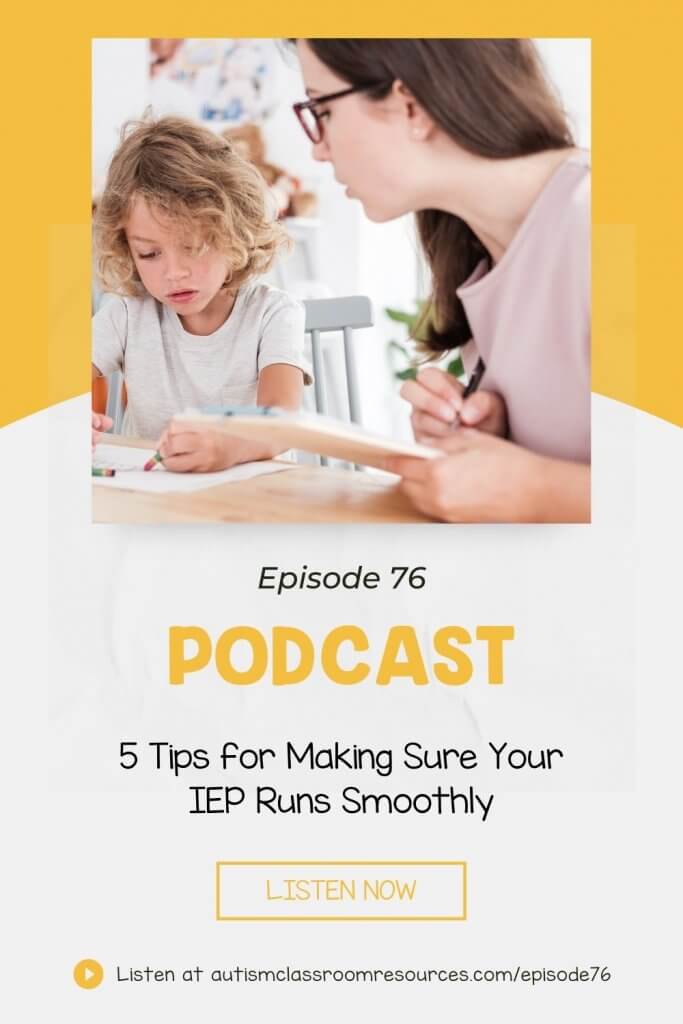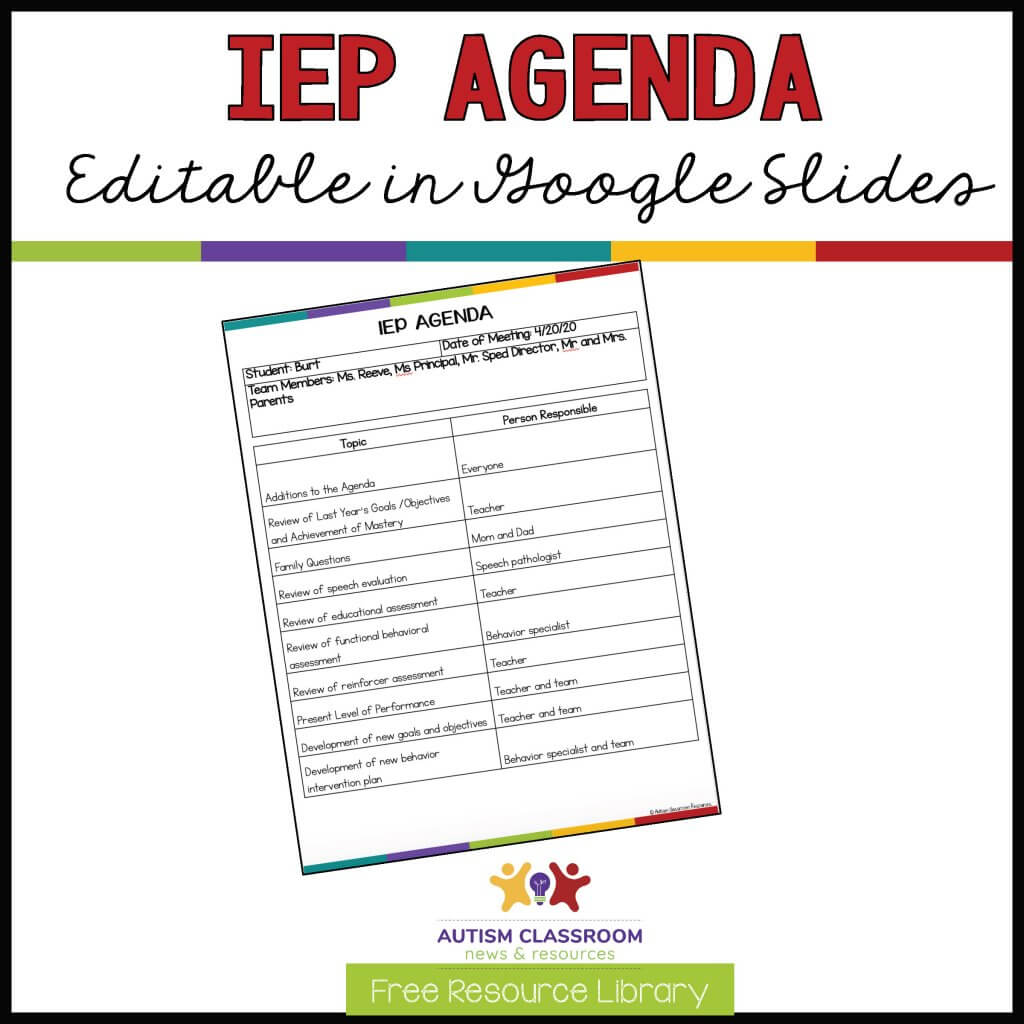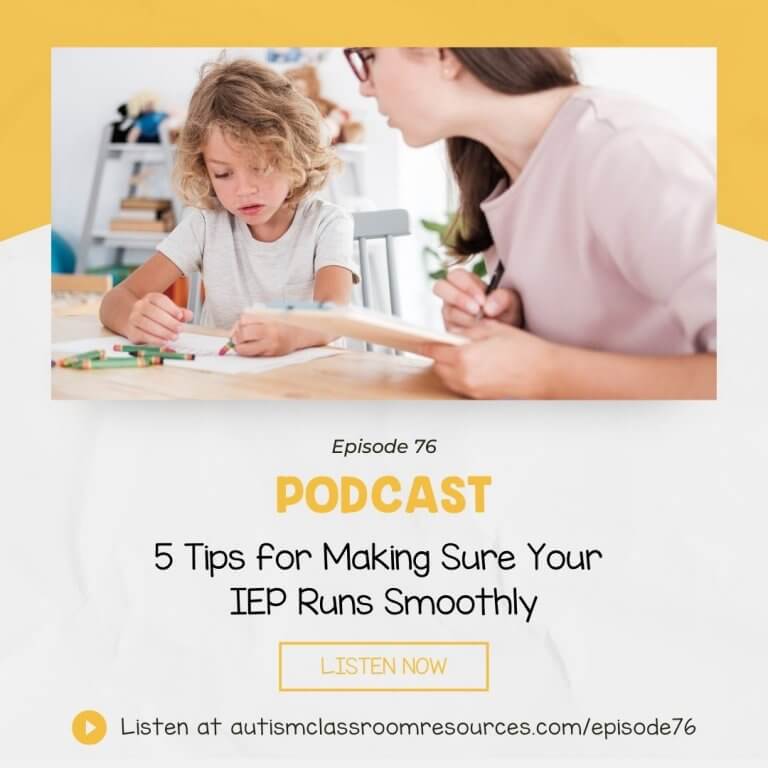Welcome to the Autism Classroom Resources Podcast, the podcast for special educators who are looking for personal and professional development.
I’m your host, Dr. Christine Reeve. For more than 20 years, I’ve worn lots of hats in special education, but my real love is helping special educators like you. This podcast will give you tips and ways to implement research-based practices in a practical way in your classroom to make your job easier and more effective.
Welcome back to the Autism Classroom Resources Podcast. I am very glad that you have joined us today. I am Chris Reeve. I’m your host. And we are talking about IEPs as we are getting ready for IEP Bootcamp in Special Educator Academy, but also getting ready for thinking about the classroom in the coming year. And IEPs can definitely be intimidating. Some, obviously, are more intimidating than others. I always get to go to the ones that are the most intimidating, and that’s why I often got called into districts to work was because there was a problem. I’ve spent most of my career doing consultation to school districts, often around times when there were problems when schools and parents were not getting along. So I got pretty good at figuring out the things that we really wanted to have in place to make sure that the meeting went smoothly.
And if you’ve ever heard me train or talk about classroom setup, you’ve heard me use the Mary Poppins quote, “Well begun is half done,” which is my terrible British accent. It’s true, though, of almost everything. And it’s definitely true of IEPs. Those meetings can go off the rails before they begin. So the better prepared you are, the smoother they go. And truly, the smoother the IEP, the smoother the school year. Yes, there are exceptions, but in general, that is a good rule to go by.
Over the years, I’ve made lists of the things that I think are the most important to do to help the meetings go smoothly. I’m going to share those things today and help you get your relationships with families off on the right foot with a well-run meeting. And then I have another episode coming up about how to best collaborate with families and work effectively as a team, which is no small feat in and of itself. Now, I’ve got a couple of free downloads for you on the website for this episode. So you can grab those and a transcript at autismclassroomresources.com/episode76. So let’s get started.
The first thing that I think is very important for any IEP, obviously, is before the meeting, but at the very least during the meeting, make sure that you get the parents’ input. Send home a form. Ideally, we would all come together in a meeting. We would write the IEP from scratch. But that would take way too much time for everybody. I have done that in some situations where we really needed to do it. But that is not really ideal for time.
Having the parents’ input into what they want out of the IEP goes beyond just a vision statement that most IEP forms require. It involves finding out what they see as their child’s strengths and needs, how the skills that you are seeing or not seeing in the classroom are being seen at home, and what they want for their child in the future. In addition, asking the family, “What do you want for your child,” is a pretty broad question. And I would venture that most parents of all children would have a hard time answering that off the top of their head. So think ahead and send home a questionnaire of some type of communication that directly ask questions about information regarding the student’s behavior at home, his skills at home, and what they perceive his needs and strengths to be. And I will include some links to examples that are out on the web in the blog post for this.
Number two. Prepare to talk about your experience. It’s really important to be prepared to talk about your background and what you do. You’re working with their child all day, five days a week, and it’s only normal that parents want to know how qualified you are to do the job. Don’t assume that just because you know you’re qualified and that the district wouldn’t hire you if you weren’t qualified that the parents will trust and assume that. I’ve been in a lot of situations where teachers were extremely qualified to teach a student on the spectrum, but became very defensive when parents asked about their qualifications.
And if you think about it, if I have surgery, I want to make sure that the surgeon is qualified to do the job well. I have the opportunity to see his or her diplomas on the wall. I get referrals from my other doctors and friends. I check out the hospital. I may even ask the doctor how many times he or she has performed that particular operation. What you do every day as a teacher is as important as surgery. And some parents would even say it’s even more critical because you do it every day and their children often can’t tell them about their day.
So first, don’t take it personally if someone asks about your qualifications. Then I suggest taking it to the next level. Prepare a professional portfolio of pictures and information from previous classrooms that you’ve run. If you’re a new teacher, put your training tools and your training materials that you have done together. Save examples of schedules from classrooms, pictures of visual supports, examples of data collection strategies, other examples that show how you’ve adapted your instruction to meet the needs of individual students. Talk about the training that you have been to if you’re a new teacher. Talk about your coursework, talk about your student teaching. And there’s a free download of a checklist for this type of portfolio on the website at autismclassroomresources.com/episode76. And pro tip, it’s also good if you’re looking for a job.
So number three. Set up the IEP meeting time taking the families into account to start. Please don’t be like what my eye doctor has started doing, which is just scheduling my appointment and telling me when it is. The other day she told me I had an appointment at 7:00 AM. I’m like, “No, I don’t. I’m not coming at 7:00 AM.” Think outside the box a bit, if possible. I think one advantage of the pandemic teaching is everyone’s much more comfortable with technology now. And I think virtual IEPs will probably stick around in a lot of cases. And I think that might give us more options to get families more involved in IEPs.
If it’s possible, and it isn’t always because you have lives, your coworkers have lives, but sometimes if we can consider having an IEP at different times outside of school hours. School hours don’t always work for working families. And that makes it hard for them to participate. Consider setting up multiple meetings if you’re anticipating a lengthy meeting. Two hours is really pretty much the limit for everybody’s attention span. So if it’s going to take longer than that, I would consider setting up multiple meetings at the start. Send home multiple times and let families choose from them. Use an online tech like Doodle.com and find out what time works for them and the team members and find times that overlap. That’s how I schedule a lot of meetings now. Call parents, ask what works for them, and then schedule it. Just avoid sending home a notice with a time. I don’t think we do that as much as we used to, but we definitely want to make sure that we’re trying to get them to the meetings.
And number four. Use an agenda. I know that that’s old hat. I know you’ve probably heard it before. But it’s still really important. And again, there’s a freebie, there’s an editable agenda that you can download in the blog post, autismclassroomresources.com/episode76. But guess what? The IEP forms will lead you astray if you try to use them as an agenda. Raise your invisible hand if your IEP has the placement on the front page. Many do because it makes it easier for reference. But guess what? It’s the last thing that we should be discussing in the meeting because it’s based on everything else in the IEP. So a big advantage of the agenda is that it keeps us on point for the legal order of things. But another really big advantage of the agenda is that it makes it easy to redirect the team when they get off track or they get stuck, in the same way that we redirect our students with their visual schedules. Up, let’s look at the agenda. We got to get back on track.
Make sure that you ask what others have to add to the agenda, including the parents. In fact, I often make that number one on my agenda. What additions do we have to the agenda. Because that serves as a reminder to document and get their input. And then we know that we’ve gotten it. And then you can also use it as an action plan for minutes and write down who’s following through on what you’ve decided to do.
Number five. Make sure ahead of time that you have the needed forms. This is a little different because everything now is computerized as opposed to back in the old times when we used to use stone tablets, and I mean paper. But we still get hung up on the form. And there is nothing more annoying, to me anyway, than having to wait for people to find the form. We lose the ability to focus on the important elements, the child, when we’re focused on the form.
So, number one, if you’re working on the computer, pull up or locate the needed forms on the computer before you start the meeting. And that’s particularly important if you’re using an unfamiliar computer, which many times you are because you’re in a conference room. Number two. Make sure that you have a printer and you know how to access it in order to print the signature pages you need before the family leaves. Make sure you can do that before you start the meeting.
And number three, print copies. For those of you who have good eyesight, you may be able to see it when you project that IEP on a projector at the front of the conference room, but I’m almost blind. And when something is projected with light, I cannot follow it that way. And I realize that we’re trying to save paper and I love that. But if I have to choose between making good decisions about a child’s future and paper, I’m going to choose the child. And I’m sorry, but we’ll recycle, I promise. And if you’re doing a distance or a virtual IEP, because I don’t think that they’re going to go away, consider mailing a draft or a copy home so they have a hard copy, because not all of your families will have a printer to be able to print it out. So I think that that is really important.
So just to recap, some of the things that you can do to make sure they go smoothly, get your parents’ input before the meeting so you’re all ready with it ahead of time. They’ve had time to think about it. Prepare yourself to talk about your experience so that you can put the parents at ease and answer questions. Set up the IEP meeting time taking the families into account and getting their input before you schedule it. Use an agenda for the meeting so that you’re following the process that you need to and can keep people on track. And then make sure that you have taken care of the forms, the printer, the computer, the copies all before you get started. So once you start the meeting, you can focus on what’s important, which is the student.
So hopefully those give you some good tips and maybe some new ones you haven’t heard before. Make sure you go over to the blog post at autismclassroomresources.com/episode76 to download your free tools from the resource library. And I want to make sure you get those. You can also get a transcript there and I’ll have some other links as well. And if you want more ideas about running successful IEP meetings or writing the IEP, come join us for the IEP Bootcamp in the Special Educator Academy. We have a free seven-day trial that you can try it out, see if it works for you. And you can fall into all of that information at specialeducatoracademy.com.
And I would love to hear your tips for how to make a meeting go well. And you can tell us in the free Facebook group at specialeducatorsconnection.com. If you’re an educator, hop over, answer the three questions, and we will get you in there to share your ideas. We would love to hear what you have to say. Thank you as always for everything that you do for your students. And I hope you’ll be back next week for another tip on the IEP and classroom development process.









